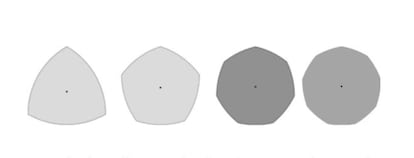
If, given an equilateral triangle, we draw two circles with centers at the three vertices and a radius equal to the side of the triangle, the intersection of said circles is a Reuleaux triangle, named in honor of the German engineer Franz Reuleaux (1829-1905), considered the father of kinematics. (Can you calculate the area if we take the side of the equilateral triangle as unit?).
The Reuleaux triangle is the simplest figure of constant width after, of course, the circle. And, as AlienJ Campo points out in response to last week’s question: “Other gutter shapes that prevent falling into the hole could be the Reuleaux triangle or other polygons of the same type, although they would be less practical both for construction and for closing the hole, because they would not rotate on the edge of the support as easily.”
A figure of constant width is one which, if we enclose it between two parallel lines tangent to it, the distance between said parallel lines is always the same, regardless of the position of the figure.
The Reuleaux triangle, although its kinematic study and mechanical applications are owed to the engineer who gave it its name, has been known since ancient times. Leonardo da Vinci used it in his octant projection (but that’s another article), and we find it in the Gothic windows of some churches, including the Sagrada Familia.
With any regular polygon with an odd number of sides we can create a construction similar to that of the Reuleaux triangle by tracing from each vertex a circle that passes through the two vertices of the opposite side. In this way the various Reuleaux polygons are obtained, which are also of constant width and, therefore, candidates for manhole covers. And not just tapas: there are also bicycles whose wheels are Reuleaux polygons (can you think of what the advantages could be compared to circular wheels?).

Why are there no regular Reuleaux polygons with an even number of sides? Or are there? Can figures of constant width be obtained from irregular polygons?
As regards the possible shapes of sheathable swords, in addition to the straight-bladed sword and the saber whose curvature is an arc of circumference, a helical sword could also be sheathed; but it doesn’t seem like this corkscrew sword would be very practical.
The peak of the amphora
The peculiar shape of Roman amphorae has sparked much debate among my gentle readers, especially due to their pointed finish, which at first glance seems impractical. However, that solid and very solid beak allowed the amphorae to be handled with a certain roughness. It was a sturdy cork when they placed them on the ground, and you could even drag them without much effort and without fear of them breaking (the enormous number of Roman amphorae that have survived intact to the present day is impressive). Additionally, the spout acted as a third handle when they lifted to pour the contents. And last but not least, when storing the amphorae in the hold of a ship, which was their usual means of transport, the tips of one row were fitted between the necks and handles of another row, thus obtaining a compact and stable stowage.







